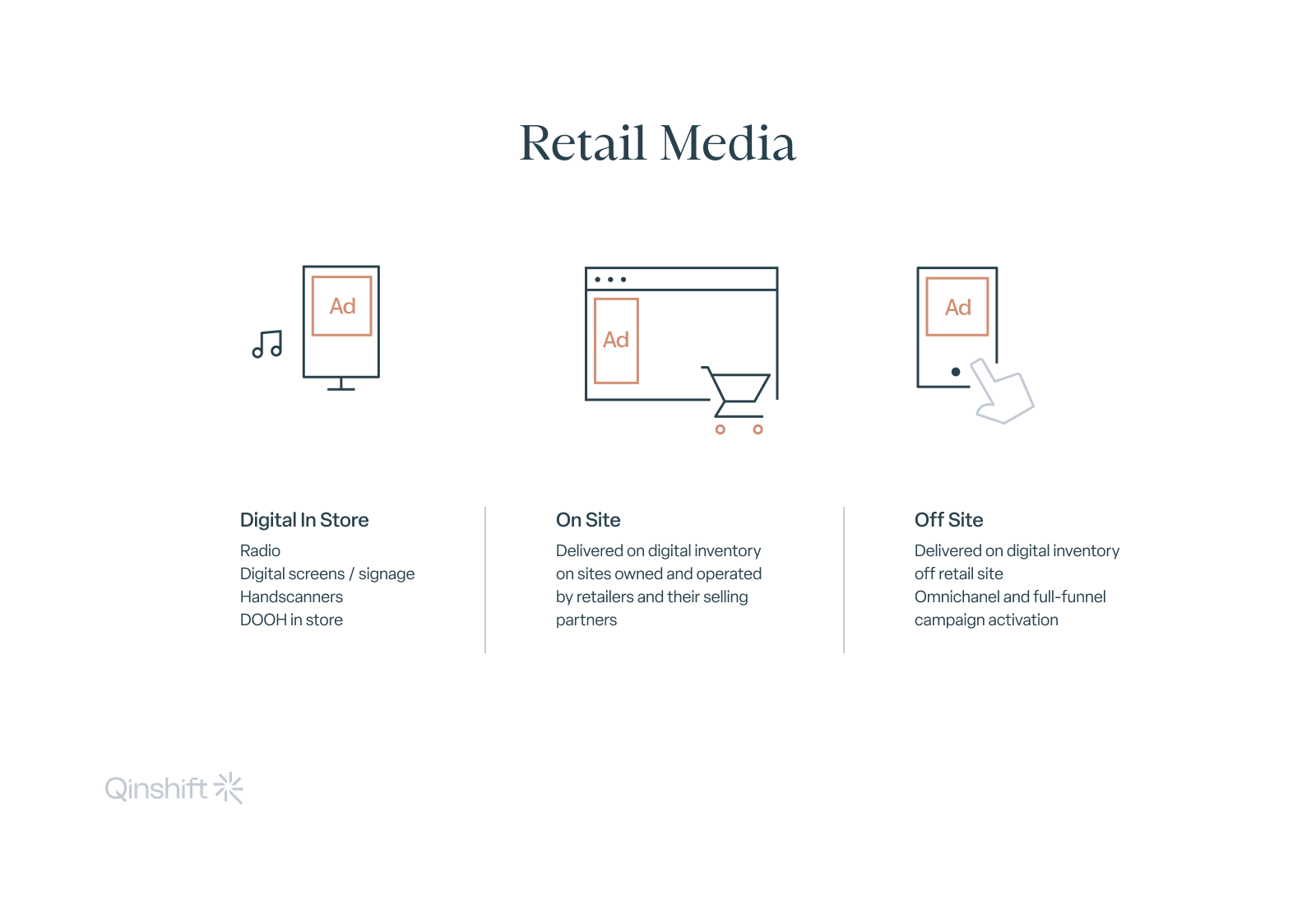The Main Challenges In Retail Media And How To Solve Them

Retail media is said to be the third wave of digital advertising. Over 90% of advertisers already collaborate with retailers to reach current and potential customers. This pattern will surely continue.
According to IAB Europe, by 2026, the amount spent on online retail media advertising would surpass that of traditional linear TV advertising, amounting to €25 billion. However, as retail media grows, the industry faces growing complexity.
Key Points
-
The main retail media challenges revolve around establishing common standards in measurement, the educational gap, building a value proposition, and technology.
-
Establishing measurement standards across online, off-site, and in-store channels in retail media requires the creation of standardised criteria for tracking marketing campaigns-related efforts; the solution involves adopting a standardised approach to data collection, implementing Retail Media Measurement Guidelines by the IAB and MRC, and prioritising monitoring and measurement mechanisms for real-time insights, and attribution modelling.
-
The educational gap in the retail media landscape leads to potential conflicts between retailers, AdTech companies and advertisers. IAB Europe created a 101 guide on retail media to bridge the gap. A more comprehensive solution involves hiring experts with specialised knowledge in the underlying technologies of retail media for practical implementation and optimisation of campaigns.
What Is Retail Media?
Retail media refers to retailers or marketplaces offering access to their digital advertising space, retail data assets, and in-store opportunities, allowing brands and agencies to run advertising campaigns within the retail environment.
The main ways brands and agencies use retail media are to increase sales, promote brand recognition, and promote new products. Within the retailers’ environment, they can target their audiences, optimise their campaigns, and create comprehensive reports to measure their digital campaigns' effectiveness.
IAB Europe classifies retail media into three categories:
-
On-site digital retail media: This pertains to the sale of advertising space on the retailer's own digital platforms, including websites, mobile applications, and online marketplaces.
-
Digital retail media: Involves leveraging a retailer's customer data to display advertisements not only on the retailer's website but also on external websites or apps. This encompasses various media formats and often includes direct links to the retailer's products.
-
In-store digital retail media: Encompasses advertising opportunities provided within the physical stores by retailers. These opportunities are extended to advertising agencies and brands, covering digital platforms like radio, DOOH screens, TV, ATMs, and hand scanners.

Having access to big amounts of first-party data and the ability to advertise at the point of purchase combined with closed-loop attribution are the key drivers for the growth of retail media. But along with big opportunities come challenges that the industry needs to solve.
The Main Challenges In Retail Media
Retail media has evolved significantly and become more complex in recent years. Keeping up with these changes poses a challenge for retailers and AdTech companies.
Challenge #1: Lack of measurement standards
One of the most important parts of an advertising campaign is the ability to measure its performance. Knowing whether a campaign produced the desired results is not only important for measuring business success, it’s also a key part of the media-planning process. However, measurement challenges extend beyond just measuring campaigns.
Retail media spans various channels, from online platforms to in-store displays. Each environment may require different metrics and measurement approaches to gauge success accurately.
Moreover, retailers often employ a combination of online and in-store strategies. Establishing measurement standards that seamlessly integrate data from these channels is crucial for the outcome, i.e., continuous improvement.
Going into a more granular view, retail media campaigns may involve multiple touchpoints, and developing effective attribution models is essential for understanding the true impact.
The challenge around measurement standards in retail media lies in establishing uniform and widely accepted metrics that accurately capture the effectiveness and impact of advertising campaigns within the robust retail environment. Given the diverse nature of retail media, which includes online, off-site, and in-store channels, creating standardised measurement criteria is complex.
Solution
Retailers, brands, and AdTech companies need a standardised approach to data collection to facilitate meaningful comparisons and analysis. The IAB and MRC created the Retail Media Measurement Guidelines, which are now available for public discussion.
At the same time, establishing measurement mechanisms to track the performance of retail media campaigns is crucial to achieving success.
This means that retail platforms should have tools and processes for real-time monitoring, gathering actionable insights, attribution modelling, and adapting strategies based on performance data.
Solving the challenge of measurement standards in retail media involves collaborative efforts within the industry. Establishing common frameworks, metrics, and attribution models can provide a foundation for accurate and meaningful performance evaluation across different retail environments. Ongoing education and communication are vital to ensuring widespread adoption and understanding of these standards.
Challenge #2: The educational gap
Another significant challenge in the retail media landscape is the educational gap among the participants in the retail media space, i.e., media agencies, retailers, retail media networks, and AdTech companies. This gap means there is a lack of understanding of each other's spaces and roles, leading to potential misunderstandings or conflicts.
In terms of a more technical angle to this challenge, the industry needs to focus on understanding how retail platforms actually work. Industry leaders underscore the importance of recognising the sources of traffic specified for different market verticals.
Spreading the knowledge and bringing a common understanding of challenges specific to each vertical will help brands and agencies better plan media campaigns and create suitable solutions.
Solution
IAB Europe has created a 101 guide to bridge the educational gap. The guide aims to provide essential insights and enhance understanding across different verticals within the retail media ecosystem.
Additionally, industry leaders actively promote educational events such as webinars and workshops to share knowledge and foster collaboration.
But is this sufficient for solving the challenge? From a technical standpoint, it’s not.
Hiring experts with a deep understanding of the underlying technologies that drive retail media is the way to go. This is particularly important in the context of data analysis, where the complexities of interpreting and deriving actionable insights from large datasets demand specialised knowledge.
These experts can contribute to the practical implementation of retail media strategies and campaigns' continuous evolution and optimisation. Their technical expertise ensures a more comprehensive understanding of the intricate systems that power retail media.
Challenge #3: Building a value proposition
To encourage advertisers to include retail media in their marketing campaigns, retailers need to focus on building a value proposition close to advertisers' needs. The challenge of doing that revolves around data utilisation and delivering unique offerings with retail media platforms.
Breaking away from the image of conventional media and showcasing the unique advantages of retail media is critical to this case.
Solution
The wealth of data and its accessibility place retail media in the lower funnel. However, retail media demonstrate the capability to drive value across the entire customer journey.
Brands' core objective is to extract valuable insights from successful and unsuccessful campaigns and convert them into actions. So, developing mechanisms to capture and analyse campaign data, providing a foundation for refining strategies, and creating more impactful retail media solutions will help achieve that objective.
But data analysis is just one part of the solution.
To break away from the image of conventional media, retailers and AdTech companies would benefit from ensuring a broader reach and better data utilisation.
To do so, retail media platforms should incorporate more advertising elements, such as sponsor products, banners, video ads, email ads, DOOH, etc.
Retailers and AdTech companies should focus on delivering holistic platforms that are reliable and aligned with advertiser strategies. Supporting brand building and customer retention plays an important role here as supporting and showcasing the understanding of advertisers' needs.
Embracing the full spectrum of customer data and journey, retail media can emerge as a powerhouse in delivering impactful and tailored advertising solutions.
Challenge #4: Technology
As the retail media landscape continues to evolve, the role of technology becomes increasingly critical. From understanding the intricacies of e-commerce platforms to navigating segmentation strategies, the challenges in this arena are multifaceted.
Lack of understanding of e-commerce platforms and traffic sources
The first tech-related challenge is navigating the complexities of e-commerce platforms; thus, understanding diverse traffic sources is a hurdle for advertisers.
Addressing this challenge requires a comprehensive understanding of platform functionalities, recognising the nuances of various traffic sources, and adapting AdTech technology and strategies to fit the unique characteristics of different market verticals.
Technological adaptation over big budgets
The traditional scenario where big brands benefited from big budgets is evolving. Now, advertisers with smaller budgets want to utilise technological capabilities, and retailers need to adapt.
Adapting to this change involves a commitment to staying informed about technological advancements and modifying solutions that provide optimal results, regardless of budget constraints.
Historical shopper data integration
Integrating historical shopper data is crucial for improving campaign relevancy. However, challenges exist in gathering and effectively utilising this data to inform strategies.
Overcoming this challenge involves investing in analytics tools and expertise to extract actionable insights from historical shopper data. This ensures that a deep understanding of audience behaviour informs campaigns.
Looking at building a retail media network
(RMN)?
Our team of AdTech & MarTech development specialists can help you design,
build and launch a retail media network.

